1-4 Evolution of the Human Brain and Behavior
Anyone can see similarities among humans, apes, and monkeys. Those similarities extend to the brain as well. In this section, we consider the brain and behaviors of some more prominent ancestors that link ancestral apes to our brain and our behaviors. Then we consider the relation between brain complexity and behavior across species. We conclude by surveying leading hypotheses about how the human brain evolved to become so large and the behavior that it mediates so complex. The evolutionary evidence shows that we humans are specialized in having an upright posture, making and using tools, and developing language but that we are not special, because our ancestors also shared these traits, at least to some degree.
Humans: Members of the Primate Order
Humans are members of the primate order, a subcategory of mammals that includes apes, Old World monkeys, New World monkeys, tarsiers, and lemurs as well (Figure 1-9). We humans are but one of about 275 primate species. Primates have excellent color vision, with the eyes positioned at the front of the face to enhance depth perception. They use their highly developed visual sense to deftly guide their hand movements.

Female primates usually have only one infant per pregnancy, and they spend a great deal more time caring for their young than most other animals do. Primate brains are on average larger than those of animals in other mammalian orders, such as rodents (mice, rats, beavers, squirrels) and carnivores (wolves, bears, cats, weasels).
Humans are members of the great ape family, which includes orangutans, gorillas, and chimpanzees. Apes are arboreal animals with limber shoulders that allow them to brachiate in trees (swing from one handhold to another), a trait retained by humans, who generally do not live in trees these days. Nevertheless, freeing the arms at the shoulder is handy for all sorts of human activities, from traversing monkey bars on the playground to competing in the Olympic hammer toss to raising a hand to ask a question in class. Apes are distinguished as well by their intelligence and large brain, traits that humans exemplify.
Among the apes, we are most closely related to the chimpanzee, having had a common ancestor between 5 million and 10 million years ago. Between that common ancestor and us over the past 5 million years, many hominids—primates that walk upright—
Australopithecus: Our Distant Ancestor
One of our hominid ancestors is probably an Australopithecus species (from the Latin austral, meaning southern, and the Greek pithekos, meaning ape.) Figure 1-10 shows reconstructions of the face and body of one such animal, Australopithecus africanus. Many species of Australopithecus lived, some at the same time, so it is uncertain which is our common ancestor.
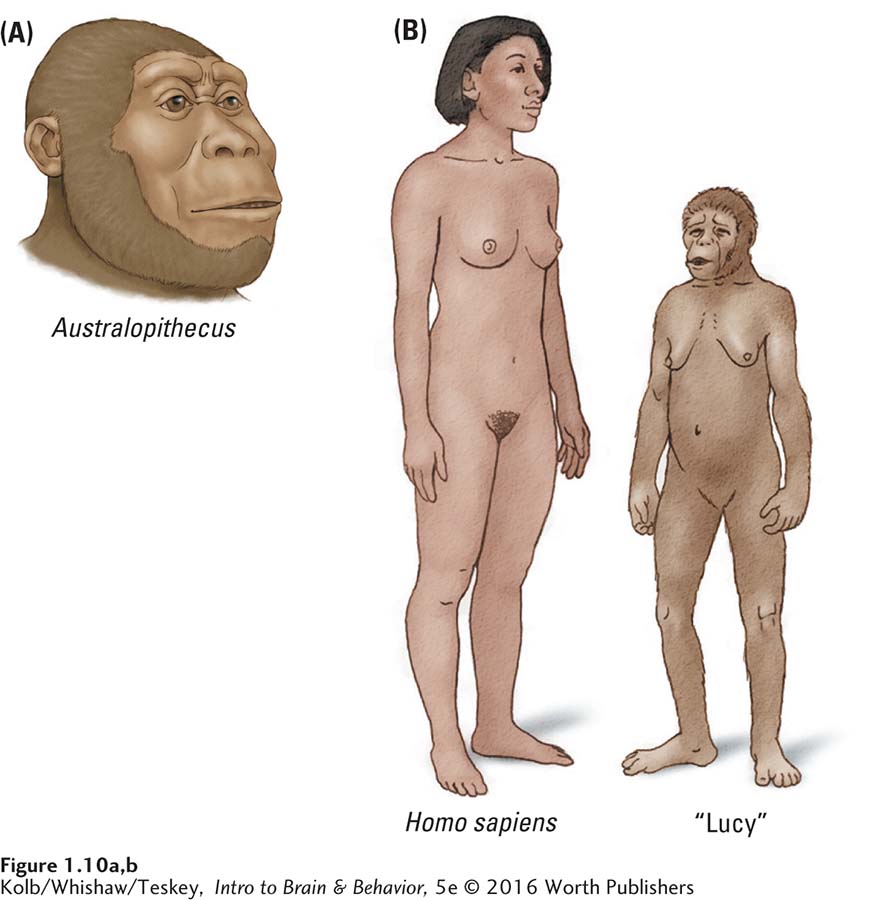
Australian Raymond Dart coined Australopithecus in naming the skull of a child he found among fossilized remains from a limestone quarry near Taung, South Africa, in 1924. Choosing so to represent his native land probably was no accident.
These early hominids were among the first primates to show distinctly human traits, including walking upright and using tools. Scientists have deduced their upright posture from the shape of their back, pelvic, knee, and foot bones and from a set of fossilized footprints that a family of australopiths left behind, walking through freshly fallen volcanic ash some 3.8 million years ago. These footprints feature impressions of a well-
The First Humans
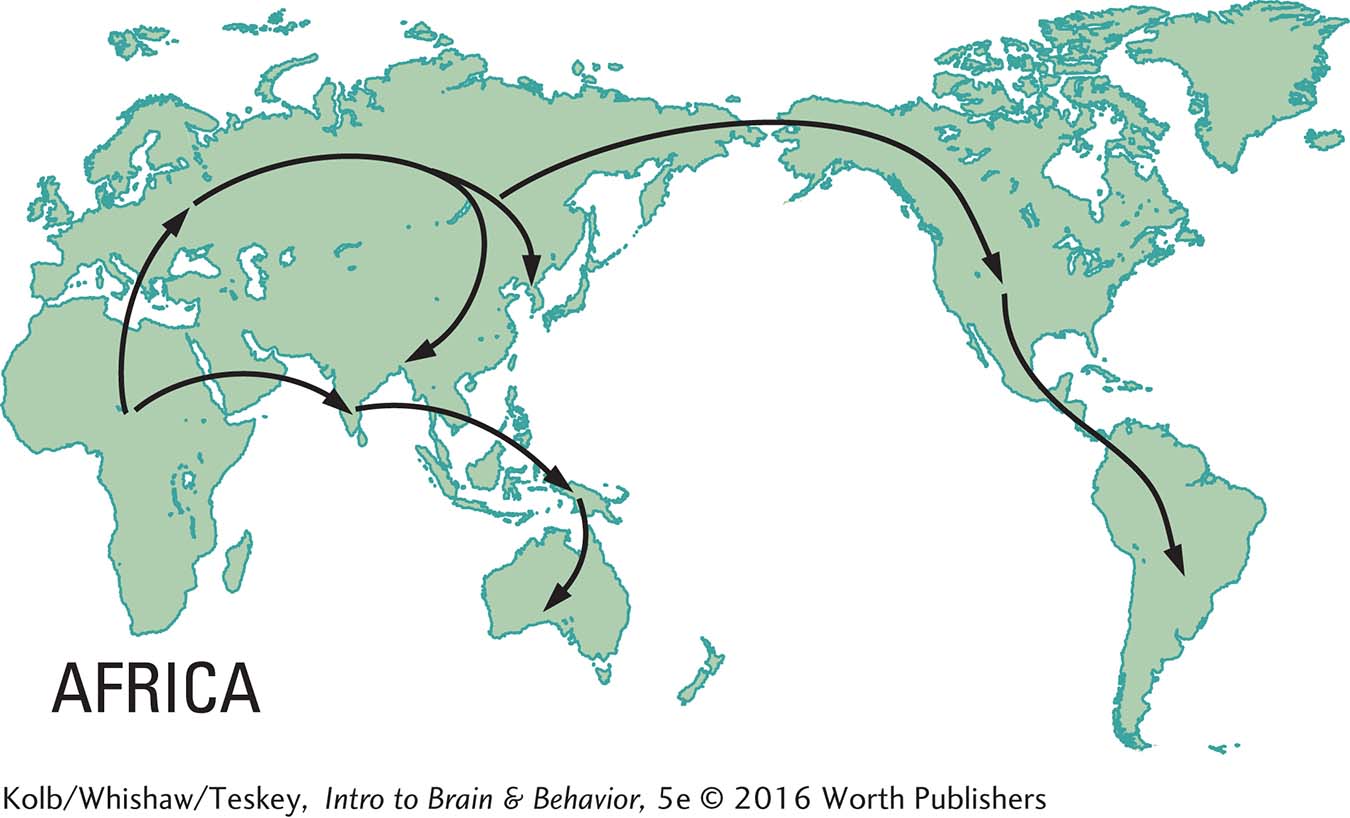
One of the first finds to be designated as genus Homo (human) dates to about 2 million years ago. The remains were found by Mary and Louis Leakey in the Olduvai Gorge in Tanzania in 1964. The primates that left these skeletal remains had a strong resemblance to Australopithecus but more closely resembled modern humans in one important respect: they made simple stone tools. The Leakeys named the species Homo habilis (handy human) to signify that its members were toolmakers. To date, the earliest member of the genus Homo, found in Ethiopia, dates to about 2.8 million years ago. The fossils reveal a jaw and teeth much smaller than in any Australopithecus species but characteristic to humans (Villmoare et al., 2015).
The first humans who spread beyond Africa migrated into Europe and Asia. This species was Homo erectus (upright human), so named because of the mistaken notion that its predecessor, H. habilis, had a stooped posture. Homo erectus first shows up in the fossil record about 1.6 million years ago. As shown in Figure 1-11, its brain was bigger than that of any preceding hominid, overlapping in size the measurements of present-
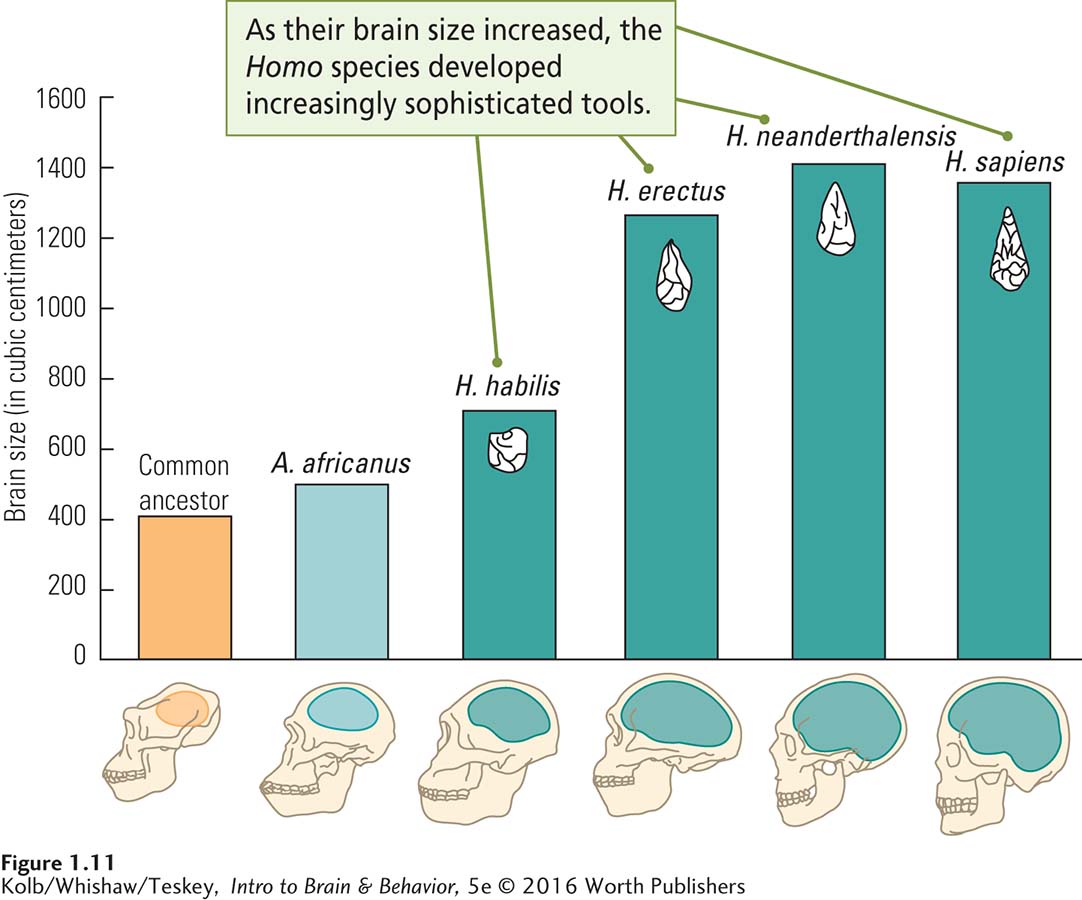
Modern humans, Homo sapiens sapiens, appeared within about the past 200,000 years. Most anthropologists think that they also migrated from Africa. Until about 30,000 years ago in Europe and 18,000 years ago in Asia, H. sapiens sapiens coexisted and interbred with other H. sapiens species, collectively called archaic humans. In Europe, for example, H. sapiens sapiens lived alongside another subspecies of modern humans, H. neanderthalis, named for the Neander Thal (Valley), Germany, where the first Neanderthal skulls were found. As the first fossil ancestral humans to be discovered, Neanderthals have maintained a preeminent place in the study of modern human ancestors.
Neanderthals had brains as large as or larger than those of modern humans, used similar tools, and wore jewelry and makeup. They lived in family groups similar to modern human ones, made music, cared for their elders, and buried their dead. From these archeological findings, we can infer that Neanderthals probably communicated using language and held religious beliefs.
We do not know how modern humans completely replaced archaic human species, but perhaps they had advantages in toolmaking, language use, or social organization. Contemporary genetic evidence shows that modern European humans who interbred with Neanderthals acquired genes that adapted them to the cold, to novel disease, and possibly to light skin that better absorbs vitamin D (Sankararaman et al., 2014). Reconstructions such as that in Figure 1-12 show how similar to us Neanderthals really were.
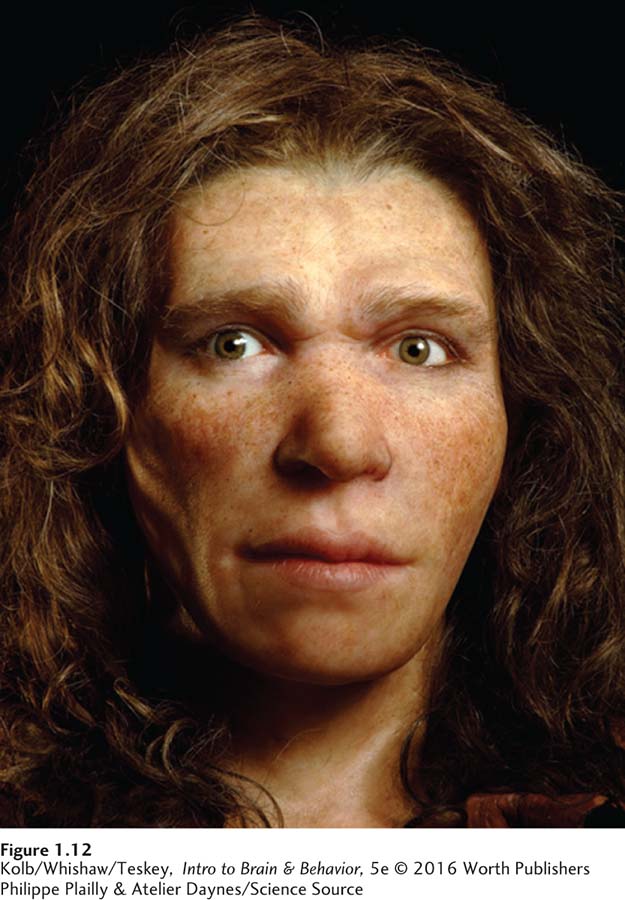
One possible human lineage is shown in Figure 1-13. A common ancestor gave rise to the Australopithecus lineage, and one member of this group gave rise to the Homo lineage. The bars in Figure 1-13 are not connected because many more hominid species have been discovered than are shown, and exact direct ancestors are uncertain. The bars overlap because many hominid species coexisted until quite recently. The last of the australopith species disappeared from the fossil record about 1 million years ago.
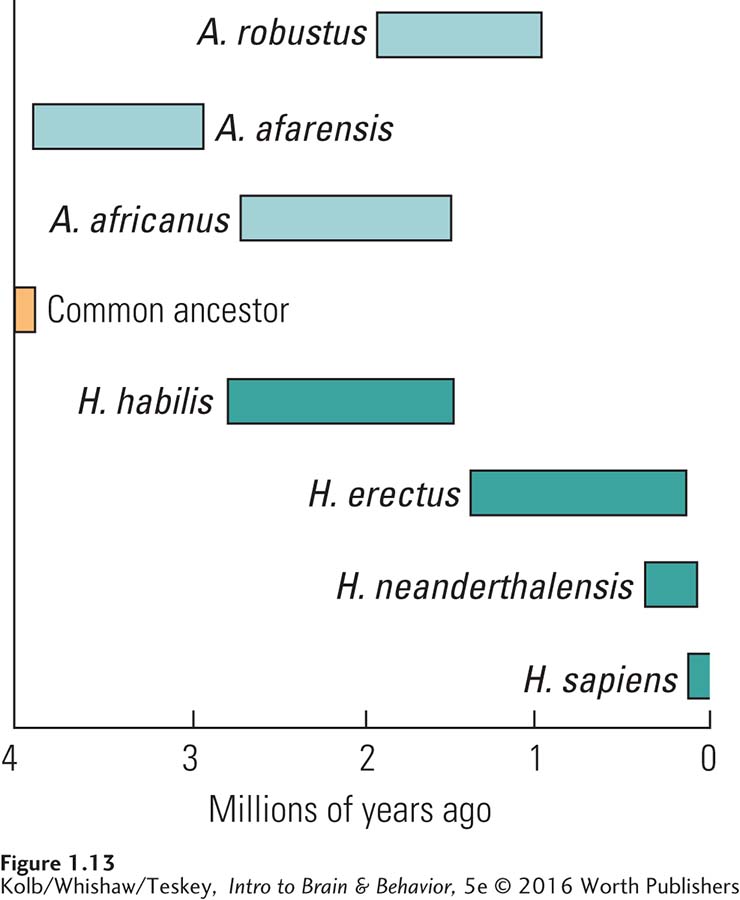
Relating Brain Size and Behavior
Scientists who study brain evolution propose that increased brain size and complexity evolved in different species to enable more complex behavior. Having a large brain clearly has been adaptive for humans, but many animals have large brains. Whales’ and elephants’ brains are much larger than ours. Of course, whales and elephants are much larger than humans overall. How is relative brain size measured, and what does brain size signify? Two ways of estimating relative brain size are to compare brain size to body size and to count brain cells.
Estimating Relative Brain–
Harry Jerison (1973) developed an index that compares the ratio of brain size to body size across species. He calculated that as body size increases, brain size increases at about two-
Using the ratio of actual brain size to expected size, Jerison developed a quantitative measure, the encephalization quotient (EQ). He defined an average animal (a domestic cat is Jerison’s pick) as having an EQ of 1. The diagonal trend line in Figure 1-14 plots the expected brain–
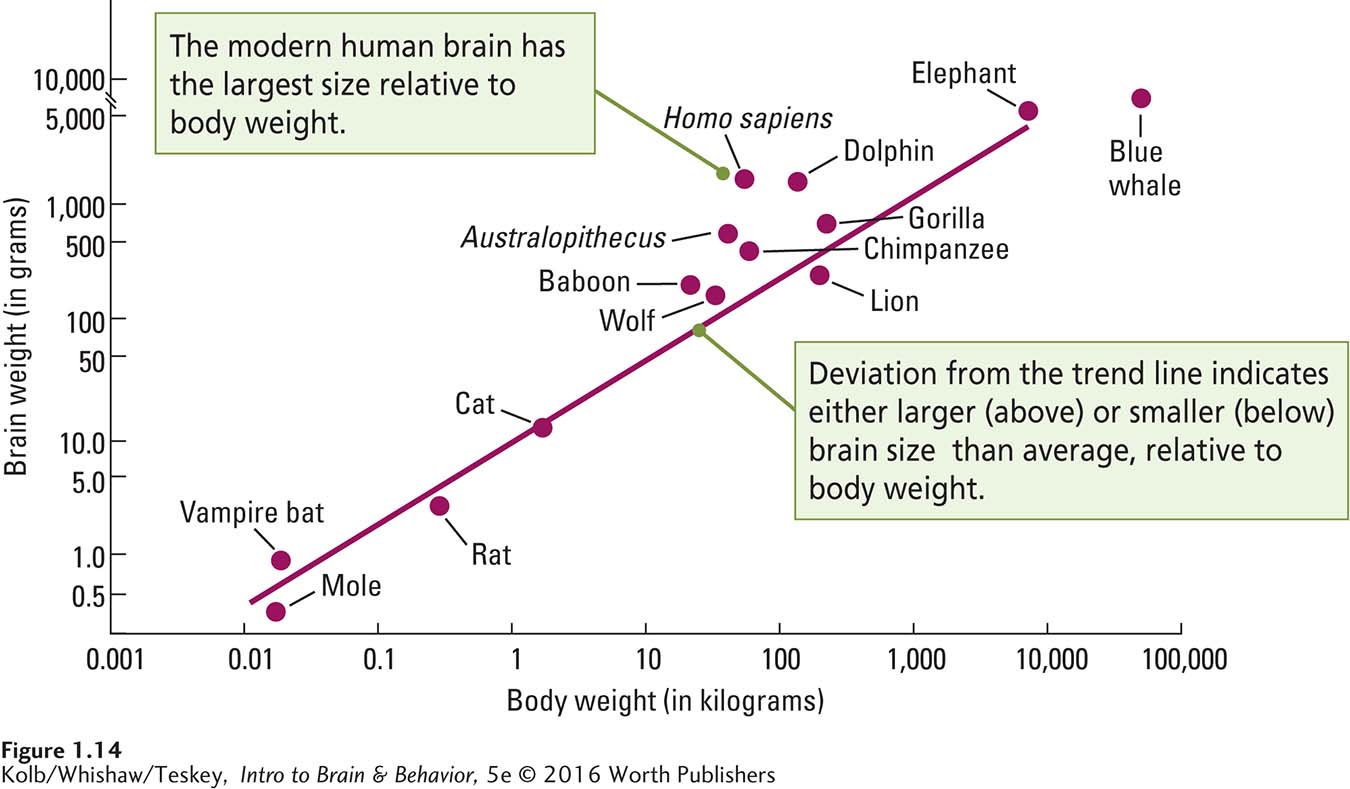
The lower an animal’s brain falls below the trend line in Figure 1-14, the smaller its EQ. The higher an animal’s brain lies above the trend line, the larger its EQ. Notice that the rat’s brain is a little smaller (lower EQ) and the elephant’s brain a little larger (higher EQ) than the ratio predicts. A modern human, farther above the line than any other animal, has the highest EQ.
Jerison’s EQ provides a rough estimate of comparative brain size, but body size and brain size can vary independently (Figure 1-15, top). To get around this problem, scientists have devised ways to count the cells in the brain.
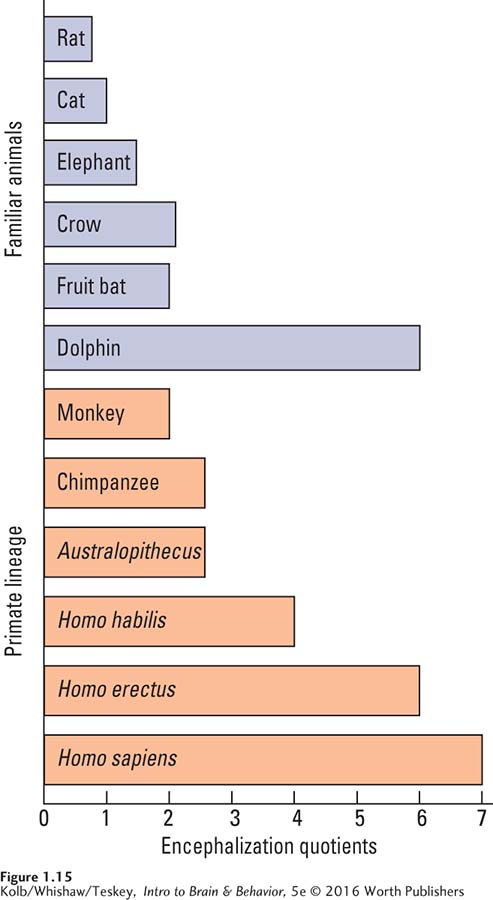
Counting Brain Cells
Consider the roundworm Caenorhabditis elegans. C. elegans has 959 cells. Of these, 302 are neurons. In contrast, the blue whale—
Based on EQs, we would predict that C. elegans has a more complex behavioral repertoire than a blue whale. But it makes no sense to suggest that a worm’s behavior is more complex than a whale’s. Obviously a whale has a lot more neurons than a worm. Our estimate of brain size and behavioral complexity line up better if we simply compare cell counts.
Karina Fonseca-
Packing density is relatively constant in the primate lineage, and so EQ provides a good comparison of their brain sizes (Figure 1-15, bottom). Brain cell counts support the EQs Jerison calculated in the primate lineage: Australopithecus had about 50 billion to 60 billion neurons, Homo habilis about 60 billion, Homo erectus about 75 billion to 90 billion, and modern humans have about 86 billion neurons.
In terms of brain size and cell counts, then, what makes us humans unusual (along with archaic humans such as Neanderthals) are our large brain and many neurons. Although researchers have not made similar neuron counts in all other animal species with brains larger than the humans', if neurons are not densely packed, resembling the somewhat less-
1-3
The Elephant’s Brain
The cerebrum and cerebellum have evolved into the human brain’s most distinct and largest structures, larger than in any other primate brain. Although the cerebellum appears smaller than the cerebrum physically, its small, tightly packed neurons are four times the number found in the cerebrum (about 68 billion vs. 16 billion), a 4:1 ratio that humans share with all other primates. Typically, the cerebrum is described as mediating cognitive functions, whereas the cerebellum mediates motor function. In fact, both structures contribute to both kinds of functions in different ways.
African elephants are enormous animals. It is not surprising that they have the largest brain of all terrestrial animals—
To investigate this question, Suzana Herculano-
What do these numbers tell us about the elephant’s behavior? An elephant has almost infinite degrees of freedom in the use of its trunk: with it, it can bathe, lift a tree trunk, pick up a peanut, caress a baby, or paint a picture. The vast number of neurons in its cerebellum is probably requisite to controlling the trunk’s sensory and motor abilities.
The elephant’s cerebral cortex boasts more neurons than most animals can boast but somewhat fewer than chimpanzees’ cerebrums. The elephant’s cognitive ability also ranks slightly lower than a chimp’s.
The Herculano-

Why the Hominid Brain Enlarged
The evolution of modern humans—

One hypothesis suggests that numerous drastic climate changes drove adaptation by hominids and led to more complex behavior. Another hypothesis contends that the primate lifestyle favors an increasingly complex nervous system that humans capitalize on. A third links brain growth to brain cooling. And a fourth proposes that a changed rate of maturation favors larger brains. Likely, a combination of all of these factors was influential.
Climate and the Evolving Hominid Brain
Climate changes have driven many physical changes in hominids, ranging from brain changes to the emergence of human culture. Evidence suggests that each new hominid species appeared after climate changes devastated old environments and led to new ones.
About 8 million years ago, a massive tectonic event (deformation of Earth’s crust) produced the Great Rift Valley, which runs through the eastern part of Africa from south to north. The reshaped landmass left a wet jungle climate to the west and a much drier savannah climate to the east. To the west, the apes continued unchanged in their former habitat. But the fossil record shows that in the drier eastern region, apes evolved rapidly into upright hominids in response to the selective environmental pressures that formed their new home.
Thereafter, the climate in East Africa did not remain static. It underwent a number of alterations (Maslin et al., 2015). The appearance of Homo habilis 3 million years ago and that of Homo erectus 1 million years ago were associated with these climatic alterations. Climatic changes also track the disappearance of other members of the human family. The warming in Europe that ended the ice age as recently as 30,000 years ago contributed to modern humans migrating to the continent and to the Neanderthal and other archaic European and Asiatic human species disappearing.
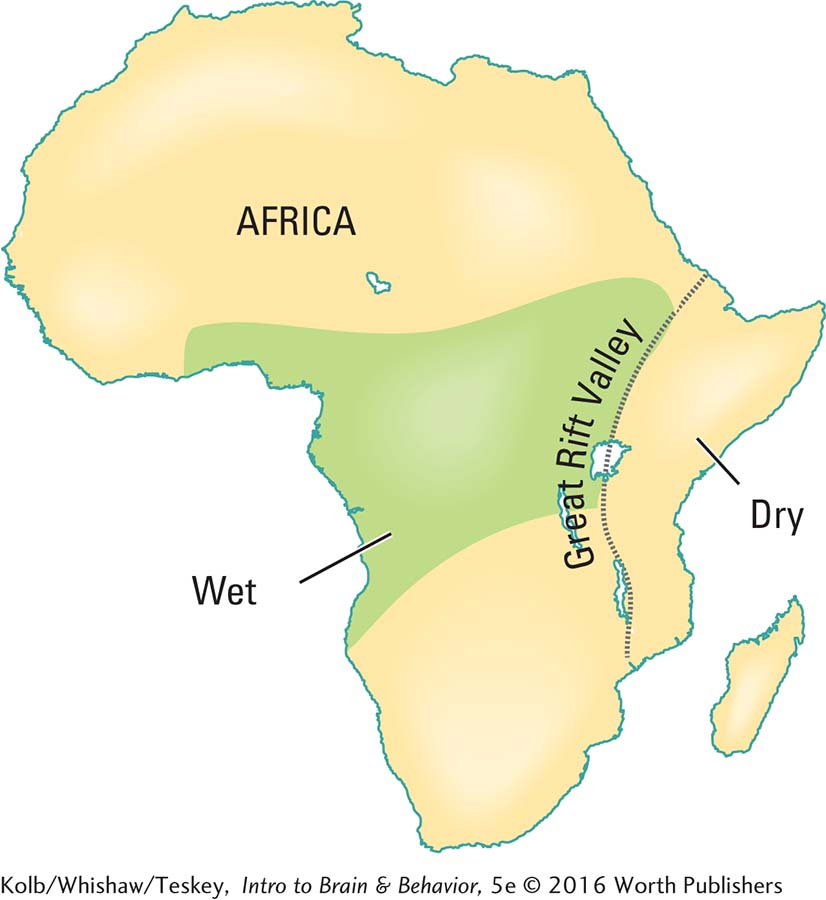
What makes Homo sapiens the survivor? One suggestion is that we modern humans evolved to adapt to change itself and that this adaptability has allowed us to populate every region on Earth (Antón et al, 2014). The caution is that modern humans have been around only a short time relative to the millions of years that other hominid species survived: our adaptability has yet to be severely tested.
The Primate Lifestyle
British anthropologist Robin Dunbar (1998) argues that a primate’s social group size, a cornerstone of its lifestyle, is correlated with brain size. His conclusion: the average group size of about 150 favored by modern humans explains their large brains. He cites as evidence that 150 is the estimated group size of hunter-
Consider how group size might affect how primates forage for food. Foraging is important for all animals, but while some foraging activities are simple, others are complex. Eating grass or vegetation is an individual pursuit: an animal need only munch and move on. Vegetation eaters such as gorillas do not have especially large brains relative to their body size. In contrast, apes that eat fruit, such as chimpanzees and humans, have relatively large brains.
Katharine Milton (2003) documented the relation between fruit foraging and larger brains by examining the feeding behavior and brain size of two South American (New World) monkeys of the same body size. As illustrated in Figure 1-17, spider monkeys obtain nearly three-
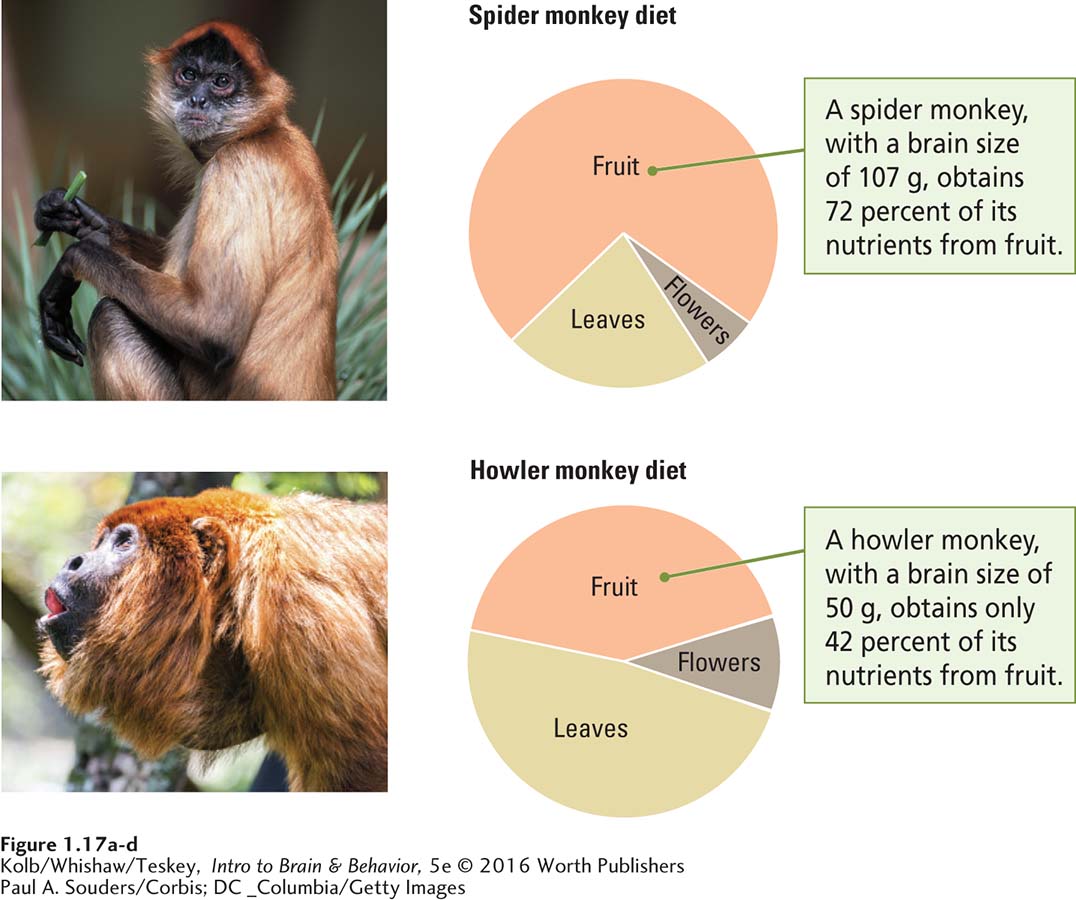
DC_Columbia/Getty Images
What is so special about eating fruit? Good sensory skills such as color vision to see it, good motor skills to reach and manipulate it, good spatial skills to find it, good memory to return to it, and having friends to help find it and ward off competitors are all useful fruit-
A neuron’s metabolic (energy) cost is estimated as relatively constant across different species but also high relative to that of other types of body cells. So any adaptive advantage to having more neurons must support that energy cost. Fonseca-
The use of fire by Homo erectus and later hominids allowed for cooking, which predigests food and thus maximizes caloric gain to the point that much less time need be devoted to foraging. A high degree of male–
Changes in Hominid Physiology
A small jaw distinguishes the earliest Homo fossils yet discovered.
Cooking might foster genetic mutations associated with marked size reductions in individual muscle fibers in the face and entire masticatory muscles in hominids (Stedman et al., 2004). The Stedman team speculates that smaller masticatory muscles paved the way for smaller, more delicate bones in the head. Smaller bones in turn allowed for changes in diet and access to more energy-
Another physiological adaptation may have given a special boost to greater brain size in our human ancestors: changes in the morphology (form) of the skull. Dean Falk (Kunz and Iliadis, 2007) developed the radiator hypothesis from her car mechanic’s remark that to increase the size of a car’s engine, you also have to increase the size of the radiator that cools it. Falk reasoned that if the brain’s radiator, the circulating blood, adapted into a more effective cooling system, brain size could increase.
Brain cooling is so important because the brain’s metabolic activity generates a great deal of heat and is at risk for overheating under conditions of exercise or heat stress. Falk argued that, unlike australopith skulls, Homo skulls contain holes through which cranial blood vessels pass. These holes suggest that, compared to earlier hominids, Homo species had a much more widely dispersed blood flow from the brain, which would have greatly enhanced brain cooling.
Altered Maturation
All animal species’ life history can be divided into stages. Heterochrony (from the Greek meaning different times) is the study of processes that regulate the onset and end of life stages and their developmental speed and duration. Several proposals suggest that altered heterochronicity accounts for the large human brain and other distinctive human features.
In neoteny, juvenile stages of predecessors become adult features of descendants. Neoteny is common in the animal world. Flightless birds are neotenic adult birds, domesticated dogs are neotenic wolves, and sheep are neotenic goats. Many anatomical features link us with the juvenile stages of other primates, including a small face, vaulted cranium, unrotated big toe, upright posture, and primary distribution of hair on the head, armpits, and pubic areas.
Because a human infant’s head is large relative to body size, neoteny has also led to adults with proportionally larger bodies and larger skulls to house larger brains. The shape of a baby chimpanzee’s head is more similar to the shape of an adult human’s head than to an adult chimpanzee’s head (Figure 1-18). Along with this physical morphology, human adults also retain some behaviors of primate infants, including play, exploration, and intense interest in novelty and learning. The brain processes that support learning thus are retained in adulthood (Zollikofer, 2012).
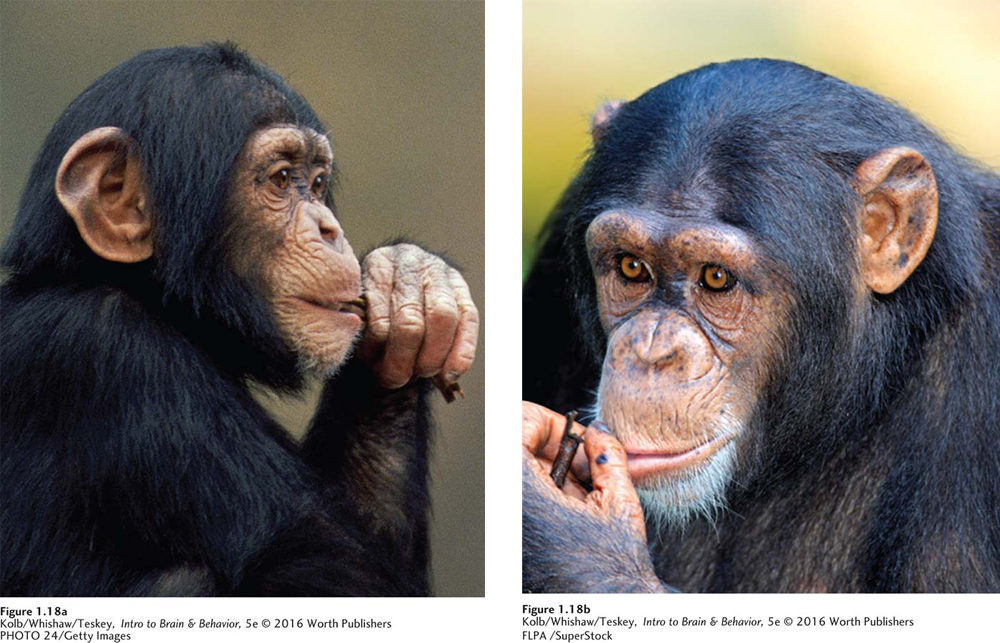
Critics of neoteny offer an alternative view in which all of the stages of development still occur, but their onset and duration change (Workman et al., 2013). Evidence for this idea is that each stage of human development—
1-4 REVIEW
Evolution of the Human Brain and Behavior
Before you continue, check your understanding.
Question 1
Modern humans share a __________ with the __________, our closest living relative.
Question 2
Modern humans evolved from a __________ lineage that successively featured __________, __________, and __________, groups in which more than one species existed concurrently.
Question 3
The __________ describes brain size relative to body size, but a complete comparison of different species’ brains requires __________.
Question 4
The large human brain evolved in response to a number of pressures and opportunities, including __________, __________, __________, and __________.
Question 5
One hypothesis proposes that Homo sapiens has evolved to adapt to change itself. Explain the reasoning behind this hypothesis in a brief paragraph.
Answers appear in the Self Test section of the book.